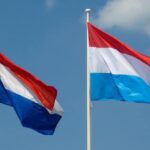Simply put, the Netherlands is a country in Western Europe. Two provinces in that country are called North and South Holland. Most major cities, including the capital, Amsterdam, are located there. Therefore, most people use the Netherlands and Holland interchangeably.
The Kingdom of the Netherlands consists of four countries
The more detailed explanation starts with the Kingdom of the Netherlands, which consists of the following four countries: The Netherlands, Aruba, Curaçao, and Sint Maarten.
“The Netherlands” refers to the Western European country and a few tiny Caribbean islands. These islands are called Bonaire, Sint Eustatius, and Saba.
Aruba, Curaçao, and Sint Maarten are also Caribbean islands. But their populations are bigger, which is why they’re considered separate countries, even though they’re still part of the Kingdom of the Netherlands.
The Netherlands’ two most influential provinces
So, 2 percent of those living in the Kingdom of the Netherlands don’t live in Western Europe. But the 98 percent that do, live in one of 12 provinces:
So, North and South Holland are only 2 out of 12 provinces. But the significance of these provinces becomes clear when we look at some of the cities located there:
As you can see, Amsterdam is located in North Holland. Strangely, even though it’s the Netherlands’ largest city and the capital of the entire country, it’s not a provincial capital.
The provincial capital of North Holland is a smaller city called Haarlem. The New York City neighborhood Harlem is actually named after this city.
In South Holland, we find two of the other internationally known Dutch cities: The Hague and Rotterdam.
The Hague is actually the administrative and royal capital of the Netherlands, and its seat of government. Apart from that, it’s also the provincial capital of South Holland. And internationally, it’s well known as the location of the International Court of Justice.
Rotterdam is the Netherlands’ second largest city. More importantly than that, however, is that the Port of Rotterdam is the largest seaport in Europe. That’s the reason many people outside of the Netherlands know about it.
North and South Holland are most densely populated
If you look at a population density map of the Netherlands, you see that North and South Holland are much more densely populated than most of the other provinces:
With a population of around 17 million people and an area of 37,354 km2 (14,422 sq. mi), the Netherlands as a whole is actually one of the most densely populated countries in the world. To get an idea of how densely populated it is, picture the entire US population moving to Texas.
But in North and South Holland, the population density is more than double the national average. To get a sense of that, imagine every single American moving to Italy and none of the Italians moving out.
The Randstad is like the Dutch Bay Area
Because the cities in North and South Holland are located so close to each other, the entire region is often viewed as one big city called the Randstad. “Rand” translates to “edge” and “stad” is the Dutch word for “city,” so it literally translates to “edge city.”
The word Randstad is not often used in casual conversation because people tend to be more specific. Most people feel more connected to the specific city they live in than the entire region. But the word Randstad is often used in the mainstream media, and in publications that compare the Randstad to the rest of the country. There’s also a well-known employment agency called Randstad, which operates in, you guessed it, the Randstad.
The Randstad has a population of over 8 million people, comparable to the San Francisco Bay Area in the US and the Rhine-Ruhr metropolitan region in Germany. But because the Netherlands is such a small country, it feels even more significant. Almost half the country’s population lives in the Randstad.
The meaning behind “the Netherlands,” “Holland,” and “Dutch”
The Netherlands is called the Netherlands simply because of the geographical characteristics of the land.
Contrary to many other Western European countries, the Netherlands doesn’t have a single mountain. Although the highest hill in the country, the Vaalserberg, is literally called a mountain in Dutch, it’s only 322.4 m (1,058 ft.) tall and most experts would say that it doesn’t qualify as such. But, by all means, judge for yourself:
“Nether” means down or below, think of your nether regions. And since the land is literally low, 26 percent of it is even below sea level, the Netherlands was considered a fitting name for this country.
Holland has a similarly pragmatic name. Holland is old Dutch for “hout land,” which translates to “woodland” in English. A reminder that, in medieval times, before it was turned into a metropolitan region, Holland used to be known for its forests. Many people who live in Holland don’t actually know that this is what the name means, by the way.
The reason the Dutch are called the Dutch is slightly less straightforward.
“Dutch” is derived from an old word that simply meant “people” or “nation.” The Germans call themselves Deutsch and their country Deutschland for this reason. Germany and the Netherlands used to be part of the same country, and during this time, both the Dutch and the Germans were called Dutch.
The Netherlands officially separated from Germany in the 17th century, and people in the Netherlands started calling themselves “Nederlanders” or “Hollanders.” But this didn’t catch on in England, and the English just continued to call them Dutch. When English became the universal language, the rest of the world adopted this habit.
And one related side note: “The Netherlands” isn’t plural in Dutch. In Dutch, the country is simply called “Nederland.”
Can you use “the Netherlands” and “Holland” interchangeably?
Even though Holland is technically only part of the Netherlands, most Dutch people also say Holland to refer to the entire country. You can even see it in the titles of national TV shows like “Holland’s Next Top Model” (the Dutch version of America’s Next Top Model) and “Heel Holland Bakt” (the Dutch version of The Great British Bake Off). These titles are not considered controversial or exclusionary.
It’s not offensive to call the Netherlands “Holland.” A minority of Dutch people in other provinces might point out that they technically don’t live in Holland, and those people will appreciate it if you say “the Netherlands.” But most Dutch people consider it a non-issue and use the names interchangeably themselves.


